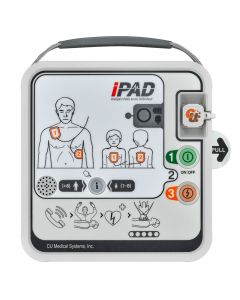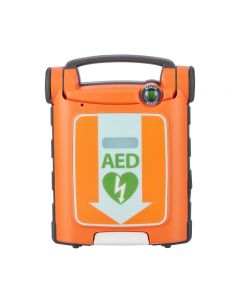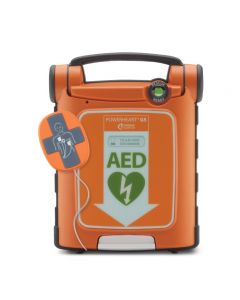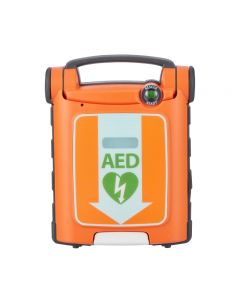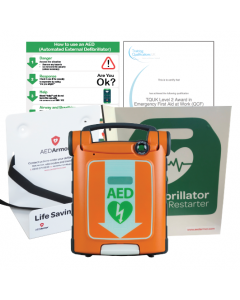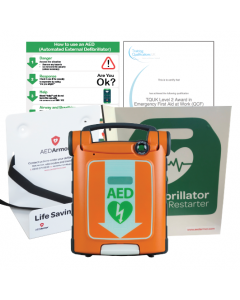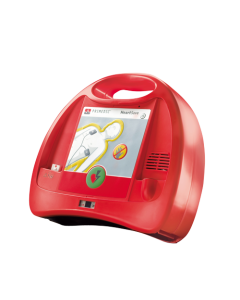-
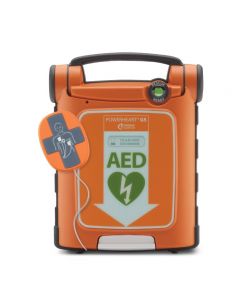 Cardiac Science Powerheart G5 Semi Automatic AED with Intellisense CPR DeviceOnly £1,350.00 £1,125.00
Cardiac Science Powerheart G5 Semi Automatic AED with Intellisense CPR DeviceOnly £1,350.00 £1,125.00 -
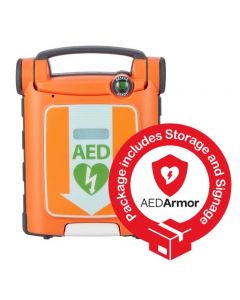 Cardiac Science Powerheart G5 Fully Automatic with ICPR Office Package
Cardiac Science Powerheart G5 Fully Automatic with ICPR Office PackageFrom £1,383.60 £1,153.00
To £1,534.76 £1,278.97
-
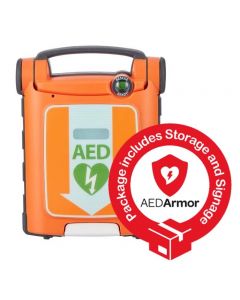 Cardiac Science Powerheart G5 Fully Automatic with ICPR and AED Armor Cabinet
Cardiac Science Powerheart G5 Fully Automatic with ICPR and AED Armor CabinetFrom £1,791.60 £1,493.00
To £1,851.60 £1,543.00
Not what you’re looking for? Use our Product Finder
Defibrillators and effective CPR are the only definitive treatment for casualties of Sudden Cardiac Arrest (SCA). Without immediate treatment, 95% of SCA's are fatal.
When the heart beats in an irregular rhythm, a shock from a defibrillator is required. This shock allows the heart to restart in a regular rhythm. Delivering a shock within 3-5 minutes after the casualty has collapsed increases their survival chance from 6% to 74%.
SCA does not discriminate and sadly, children can fall victim too. Paediatric electrode pads, child buttons, switches & keys all lower the shock level delivered to the child and ensure they receive the life-saving treatment required.
More Information
If you have any questions or are unsure about which defibrillator best suits your needs, consult our buyers guide or give our friendly & knowledgable Product Specialists a call on 0161 776 7422.
What is a defibrillator used for?
Defibrillation is the procedure used to treat life-threatening conditions that affect the rhythm of the heart. A defibrillator analyses the heart rhythm and decides whether an electric shock needs administering. It is not uncommon for some individuals to need more than one shock.
Defibrillators and effective CPR are the only treatment for casualties of Sudden Cardiac Arrest (SCA). Without immediate treatment 95% of SCA’s are fatal. Heart attack and SCA are very different and although their symptoms seem similar, a defibrillator should not be used on a heart attack victim, unless the heart attack leads to an SCA.
What is the difference between a heart attack and a cardiac arrest?
There is a difference between a heart attack and an SCA, by understanding this difference, you can be aware of the warning signs and how to help in case of an emergency. A person experiencing an SCA will collapse suddenly, lose consciousness and show no signs of breathing. Someone experiencing a heart attack will have chest pain, shortness of breath and feel weak and unwell. Do not use a defibrillator in the event of a heart attack, unless the heart attack leads to a cardiac arrest.
SCA is an electrical problem whereas a heart attack is circulatory.
Are there instances when I shouldn’t use a defibrillator?
If you suspect an individual is suffering an SCA you should start CPR immediately and use a defibrillator. The unit will analyse the heart rhythm and assess if a shock is required.
There are some additional warnings to take into consideration when using a defibrillator, such as if the patient has a pacemaker or medication patch, this is easy to spot, they appear as a small lump under the collarbone. Do not place AED pads over medical patches. Remove them first. If a cardiac sufferer is wet or lying in the water, move them away from the liquid and dry their chest off completely before attempting to administer the shock. Excess body hair can interfere with the defibrillator's ability to detect a shockable rhythm, either shave the area or apply as much direct pressure to the pads as possible to ensure conduction.
Before using a defibrillator, please call 999 for assistance.
How much do defibrillators cost?
These prices depend on the range, model and seller. Typically, the price of a defibrillator starts at £725+VAT. Defibrillators with additional features such as paediatric functionality and WiFi capability are more expensive. There are finance options available too for our business customers. Please refer to defibshop’s finance section to find out the best option for you.
Use our Product Finder to help you purchase the right defibrillator for your needs.
Are there different types of defibrillators?
There are three common types of defibrillators, including Automated External Defibrillator (AED), Implantable Cardioverter Defibrillator (ICD) and Wearable Cardioverter Defibrillator (WCD). Different types of defibrillators work in different ways. AEDs are in public spaces and were developed to save the lives of people suffering from SCA. Untrained bystanders are able to use these devices.
ICD’s are surgically placed inside the body, and WCD’s rest on the body. These defibrillators are used to prevent death among people who have a high risk of arrhythmia. ICD’s and WCD’s can only be used by medical professionals.
Where can public defibrillators be found?
If you call the emergency services and provide your location, an operator will be able to tell you where the closest defibrillator is. The Circuit is a defibrillator network that was created that connects defibrillators to NHS ambulance services within the UK. If you have bought an AED, it is important to register the defibrillator to ensure that it can be accessed quickly in case of an emergency.
How do you use a defibrillator?
Firstly, call the emergency services and start CPR, the operator will guide you through the process and help you locate the nearest AED. If it’s possible, send someone else to go and get the defibrillator, do not interrupt the CPR if you’re alone. At defibshop we provide a range of training courses to better help you understand AEDs. We offer first aid training, refreshers courses, mental health and lifeguard courses. These are accredited by our partner Imperative Training.

